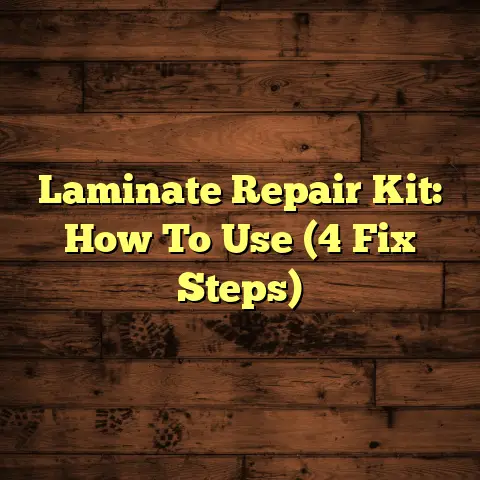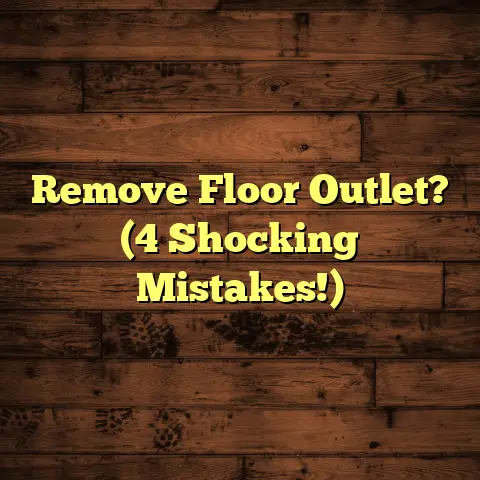The Basics Of Insulating Concrete Floors For Winter?
It’s not just about keeping your toes warm; it’s about saving serious cash, boosting your home’s comfort, and making it more energy-efficient.
Think of it as a cozy blanket for your house, but underground.
In this article, I’m going to walk you through everything you need to know, from why concrete floors get so cold to how to choose the right insulation and install it like a pro. Let’s dive in!
Section 1: Understanding Concrete Floors
So, what’s the deal with concrete floors? You see them everywhere—basements, garages, even modern living rooms.
They’re durable and versatile, but let’s face it: in the winter, they can feel like walking on ice. Why is that?
Concrete is a dense material. This means it’s great at conducting heat. In the summer, that’s a plus, helping to keep your home cool.
But in the winter, it sucks the heat right out of your feet and your house.
Concrete has a relatively low R-value (resistance to heat flow) compared to other building materials like wood or carpet.
- R-Value: A measure of thermal resistance; the higher the R-value, the better the insulation. Concrete typically has an R-value of about 0.1 to 0.2 per inch [Source: Concrete Construction Magazine].
That means heat passes through it easily. Now, imagine a large, uninsulated concrete slab in contact with the cold ground.
It becomes a giant heat sink, constantly drawing warmth from your home.
What happens when you don’t insulate?
- High energy bills: Your heating system works overtime to compensate for the heat loss.
- Uncomfortable living spaces: Cold floors make rooms feel chilly, even with the heat cranked up.
- Potential damage: Temperature fluctuations can cause condensation, leading to moisture problems and even mold growth.
Trust me, I’ve seen it all. I once worked on a house where the homeowners were spending a fortune on heating, and their basement floor was so cold it was practically freezing.
Insulating the floor made a world of difference, and they saw a significant drop in their energy bills almost immediately.
Section 2: Benefits of Insulating Concrete Floors
Okay, so we know concrete floors can be cold and energy-draining. But what exactly do you gain by insulating them?
Let’s break it down:
-
Increased Energy Efficiency and Lower Heating Costs: This is the big one. By reducing heat loss through the floor, you lighten the load on your heating system.
According to the U.S. Department of Energy, heating and cooling account for about 48% of the energy use in a typical U.S. home. Insulating your concrete floors can significantly reduce this percentage.
I’ve personally seen clients save anywhere from 10% to 25% on their heating bills after insulating their floors. It really adds up over time!
-
Enhanced Comfort Levels Within the Home: Say goodbye to cold feet! Insulated floors make rooms feel warmer and more comfortable, especially in basements and ground-level living areas.
It’s not just about temperature; it’s about how the space feels. A warm floor makes a room feel inviting and cozy.
-
Prevention of Moisture Problems and Potential Mold Growth: Concrete is porous, meaning it can absorb moisture from the ground. When warm, moist air meets a cold concrete floor, condensation can occur, leading to mold and mildew growth.
Insulation helps to keep the floor warmer, reducing the risk of condensation and moisture-related problems.
-
Improvement in the Lifespan of Flooring Materials: Constant temperature fluctuations and moisture can damage flooring materials like wood, tile, and laminate.
Insulating the concrete floor beneath them provides a stable and consistent environment, extending the life of your flooring.
I remember one job where the homeowner had to replace their laminate flooring every few years because of moisture damage.
After insulating the concrete slab, they haven’t had any issues, and their new flooring is still looking great after five years.
Real Numbers:
- A study by the Oak Ridge National Laboratory found that insulating basement floors can reduce heating energy use by up to 15% in some climates.
- The Insulation Institute estimates that proper insulation can save homeowners up to 20% on their heating and cooling costs annually.
Insulation isn’t just an expense; it’s an investment that pays off in comfort, savings, and the long-term health of your home.
Section 3: Types of Insulation Materials
Alright, let’s talk materials. There are several options for insulating concrete floors, each with its own set of pros and cons.
Here are some of the most common:
-
Rigid Foam Board Insulation: This is a popular choice for concrete floors because it’s durable, water-resistant, and has a high R-value.
Types include Expanded Polystyrene (EPS), Extruded Polystyrene (XPS), and Polyisocyanurate (Polyiso).
- Pros: High R-value, moisture-resistant, easy to install.
- Cons: Can be more expensive than other options, may require cutting and fitting.
I often recommend XPS foam board for below-slab insulation because it offers excellent moisture resistance and compressive strength.
-
Spray Foam Insulation: Spray foam expands to fill cracks and gaps, creating a tight seal. It’s available in open-cell and closed-cell varieties.
- Pros: Excellent air barrier, high R-value (especially closed-cell), fills gaps and cracks.
- Cons: More expensive than other options, requires professional installation, can be messy.
Closed-cell spray foam is a great choice for basements because it’s highly resistant to moisture and provides a very high R-value.
-
Fiberglass Batts: Fiberglass is a traditional insulation material that’s relatively inexpensive and easy to install.
- Pros: Inexpensive, readily available, easy to install.
- Cons: Lower R-value than other options, susceptible to moisture damage, can be itchy to work with.
I generally don’t recommend fiberglass for concrete floors because it’s not moisture-resistant and can lose its insulating properties if it gets wet.
-
Reflective or Radiant Barrier Insulation: This type of insulation reflects radiant heat away from the floor, helping to keep it cooler in the summer and warmer in the winter.
- Pros: Effective at reflecting radiant heat, relatively inexpensive.
- Cons: Less effective in cold climates, requires an air space to function properly.
Radiant barriers are best used in conjunction with other types of insulation, especially in colder climates.
Here’s a quick comparison table:
| Material | R-Value (per inch) | Pros | Cons |
|---|---|---|---|
| Rigid Foam (XPS) | 5.0 | High R-value, moisture-resistant, durable | More expensive, requires cutting |
| Spray Foam (Closed-Cell) | 6.5 | Excellent air barrier, high R-value, fills gaps | Most expensive, professional installation required, can be messy |
| Fiberglass Batts | 3.0 | Inexpensive, readily available, easy to install | Low R-value, susceptible to moisture damage, can be itchy |
| Radiant Barrier | Varies | Effective at reflecting radiant heat, relatively inexpensive | Less effective in cold climates, requires air space |
Choosing the right insulation material depends on your budget, climate, and the specific characteristics of your concrete floor.
Consider factors like moisture levels, R-value requirements, and ease of installation when making your decision.
Section 4: Installation Methods
Okay, now for the fun part: getting that insulation in place! There are a few different approaches, depending on whether you’re dealing with a new construction or an existing floor.
Before Pouring Concrete (New Construction):
This is the ideal scenario because you have the most flexibility.
- Planning is Key: Before you even pour the concrete, decide on the type of insulation you’ll be using and plan accordingly.
- Sub-Slab Insulation: The most effective method is to install insulation under the concrete slab. This creates a thermal break between the concrete and the cold ground.
- Lay down a layer of gravel for drainage.
- Place rigid foam board insulation (XPS is a great choice) over the gravel, making sure to overlap the seams.
- Cover the insulation with a vapor barrier to prevent moisture from wicking up into the concrete.
- Pour the concrete slab.
- Edge Insulation: Don’t forget to insulate the edges of the slab where it meets the foundation walls. This helps to prevent thermal bridging, where heat can escape through the concrete.
Retrofitting Existing Floors:
This is a bit more challenging, but definitely doable. Here’s a step-by-step guide:
- Assess the Situation: Before you start, inspect the floor for any cracks, moisture problems, or other issues. Address these before installing insulation.
- Choose Your Insulation: Consider factors like headroom, budget, and moisture levels when selecting your insulation material. Rigid foam board and spray foam are popular choices for retrofitting.
- Prepare the Floor: Clean the concrete floor thoroughly and repair any cracks or damage.
-
Install the Insulation:
- Rigid Foam Board:
- Measure and cut the foam board to fit the floor area.
- Apply construction adhesive to the back of the foam board and press it firmly against the concrete floor.
- Stagger the seams to prevent air gaps.
- Seal the seams with foil tape.
- Spray Foam:
- This is best left to the professionals, as it requires specialized equipment and training.
- The spray foam will expand to fill the space between the concrete floor and the subfloor, creating a tight seal.
- Install a Subfloor: Once the insulation is in place, you’ll need to install a subfloor over it. This will provide a smooth, level surface for your finished flooring.
- Use pressure-treated lumber for the subfloor to prevent moisture damage.
- Leave a small gap between the subfloor and the walls to allow for expansion and contraction.
- Install Your Finished Flooring: Now you can install your chosen flooring material, such as carpet, tile, or laminate.
- Rigid Foam Board:
Tools You’ll Need:
- Tape measure
- Utility knife or saw (for cutting foam board)
- Construction adhesive
- Foil tape
- Safety glasses
- Gloves
- Dust mask
Safety Precautions:
- Always wear safety glasses and gloves when working with insulation materials.
- Use a dust mask to protect yourself from dust and fibers.
- Work in a well-ventilated area.
- Follow the manufacturer’s instructions for installing insulation materials.
Using Radiant Floor Heating:
If you’re really looking to maximize comfort and efficiency, consider integrating radiant floor heating with your insulation.
Radiant floor heating systems use warm water or electric coils to heat the floor from below, providing a consistent and comfortable warmth.
When combined with insulation, radiant floor heating becomes even more efficient, as the insulation prevents heat from escaping into the ground.
- Installation:
- Install insulation under the concrete slab as described above.
- Install the radiant heating system according to the manufacturer’s instructions.
- Pour a thin layer of concrete over the heating system to create a thermal mass.
- Install your finished flooring.
I’ve installed radiant floor heating systems in several homes, and the homeowners have been thrilled with the results.
It’s a luxurious and energy-efficient way to heat your home.
Diagram Example (Retrofitting with Rigid Foam):
+-----------------------+
| Finished Flooring |
+-----------------------+
| Subfloor |
+-----------------------+
| Rigid Foam Insulation |
+-----------------------+
| Concrete Floor |
+-----------------------+
Section 5: Maintenance and Care for Insulated Floors
You’ve gone through all the effort of insulating your concrete floors. Now, how do you keep them in top shape for the long haul?
Maintenance is key to ensuring your investment continues to pay off.
Tips for Caring for Insulated Floors:
- Regular Cleaning: Keep your floors clean by sweeping or vacuuming regularly. This will prevent dirt and debris from accumulating, which can damage the flooring material and reduce its lifespan.
- Check for Moisture Issues: Periodically inspect your floors for signs of moisture, such as discoloration, dampness, or mold growth. Address any moisture problems promptly to prevent damage to the insulation and flooring.
- Monitor Energy Efficiency: Keep an eye on your energy bills to ensure that your insulation is performing as expected. If you notice a sudden increase in your heating costs, it could be a sign that there’s a problem with your insulation.
- Proper Ventilation: Ensure that your basement or crawl space is properly ventilated to prevent moisture buildup.
- Avoid Heavy Impact: Protect your floors from heavy impact, which can damage the insulation and flooring. Use mats or rugs in high-traffic areas to prevent wear and tear.
Common Problems and Solutions:
- Moisture Buildup: If you notice moisture buildup on your floors, it could be due to a leaky pipe, poor ventilation, or a high water table. Address the source of the moisture and consider installing a dehumidifier to reduce humidity levels.
- Insulation Damage: Insulation can be damaged by pests, water, or physical impact. Inspect your insulation regularly for signs of damage and replace any damaged sections promptly.
- Reduced Energy Efficiency: If you notice a decrease in energy efficiency, it could be due to air leaks, insulation settling, or other issues. Inspect your floors and walls for air leaks and seal them with caulk or weather stripping.
I once had a client who noticed a musty smell in their basement. After investigating, we discovered that the insulation had been damaged by mice, and moisture was seeping in.
We replaced the damaged insulation and sealed the area, and the problem was solved.
Long-Term Performance:
With proper maintenance and care, your insulated concrete floors can provide years of comfort and energy savings.
Regular inspections, prompt repairs, and attention to moisture control will help to ensure that your investment continues to pay off.
Conclusion
So, there you have it: the basics of insulating concrete floors for winter.
It’s a project that pays off in so many ways, from lower heating bills to a more comfortable home.
We’ve covered everything from understanding why concrete floors get cold to choosing the right insulation material and installing it like a pro.
Remember, insulating your concrete floors isn’t just about keeping your toes warm; it’s about making a smart investment in your home’s energy efficiency and long-term value.
Don’t let another winter go by with cold floors and high heating bills. Take action today and start enjoying the benefits of insulated concrete floors!
Think of it this way: It’s like giving your house a warm hug from the ground up.
Is it worth it? Absolutely!
References:
- U.S. Department of Energy: https://www.energy.gov/
- Oak Ridge National Laboratory: https://www.ornl.gov/
- The Insulation Institute: https://insulationinstitute.org/
- Concrete Construction Magazine: https://www.concreteconstruction.net/





